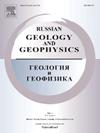俄罗斯晚前寒武纪和显生宙地层的古生物学、地层学和生物地理学
IF 1
4区 地球科学
Q3 GEOSCIENCES, MULTIDISCIPLINARY
引用次数: 0
摘要
摘要:本文讨论了文迪系分期划分的可能性,提出了西伯利亚地台复合剖面作为地层标准。对于西伯利亚地台和俄罗斯东北部的奥陶系,提出了地层图的一些变化,并考虑了区域层位与俄罗斯一般地层标度(GSS)相关关系的命名问题和不同变化。本文对北极西伯利亚地区巴约世和巴托世辉石柱状岩进行了地球化学分析,首次获得了剖面的C、O、Sr同位素综合表征,并与欧洲标准剖面进行了对比,建立了古地理模型。对Anabar Bay沉积(Laptev海)的上侏罗统和下白垩统进行了综合研究,从而改进了本参考剖面的生物地层划分,并确定了区域间和全球对比的水平。讨论了侏罗系-白垩纪界线段的磁地层划分及其与特提斯地区的对比。考虑生物地层资料,δ13Corg变化曲线也可作为对比工具。根据研究剖面标定的地震剖面解释,在Anabar-Khatanga坳陷西北部揭示了上侏罗统斜形构造。该杂岩的形成使我们可以认为这一阶段是该褶皱地区维尔霍扬造山运动的起始阶段。通过对沉积物厚度变化的分析,我们可以推断出强烈的构造-沉积过程发生在晚侏罗世,同时沉积盆地的地层也在下沉。对外贝加尔湖下白垩统上部参考剖面的特定湖相化石组合和已发表的资料分析表明,该化石组合在东亚地区分布广泛。生物相分析使重建这一时期的古环境成为可能。本文章由计算机程序翻译,如有差异,请以英文原文为准。
Paleontology, Stratigraphy and Biogeography of the Late Precambrian and Phanerozoic Formations of Russia
Abstract —This special issue is dedicated to discussing the possibility of the stage division of the Vendian system, specifically, a composite section of the Siberian Platform is proposed as a stratigraphic standard. For the Ordovician system of the Siberian Platform and Northeastern Russia, certain changes in stratigraphic charts are proposed, nomenclative issues and different variants of correlations of regional horizons with the General Stratigraphic Scale (GSS) of Russia are considered. A geochemical analysis of Bajocian and Bathonian belemnite rostra of Arctic Siberia was carried out and for the first time a comprehensive C, O, and Sr isotope characterization of the sections was obtained, making it possible to propose a comparison of the studied sections with the European standard and to develop paleogeographic models. Comprehensive studies of the Upper Jurassic and Lower Cretaceous series of the Anabar Bay deposits (Laptev Sea) led to an improved biostratigraphic division for this reference section and to the identification of the levels for interregional and global correlation. The magnetostratigraphic division of the Jurassic–Cretaceous boundary interval and its comparison with the Tethyan regions are discussed. Taking into account biostratigraphic data, the δ13Corg variation curve can also serve as a correlation tool. The clinoform structure of Upper Jurassic strata was revealed in the northwest of the Anabar–Khatanga depression, based on the interpretation of seismic profiles calibrated against studied sections. The formation of this complex allows us to consider this stage as the initiation of the Verkhoyan orogeny in this folded area. Analysis of variations in the thickness of sediments allows us to deduce that intense tectonic-sedimentary processes took place during the Late Jurassic epoch, along with subsidence of the bed of the sedimentary basin. Analysis of a specific assemblage of lacustrine fossils from the reference section of the upper part of the Lower Cretaceous series of Transbaikalia and of published data showed that this fossil assemblage was widespread in East Asia. Biofacies analysis made it possible to reconstruct the paleoenvironments of this time.
求助全文
通过发布文献求助,成功后即可免费获取论文全文。
去求助
来源期刊

Russian Geology and Geophysics
地学-地球科学综合
CiteScore
2.00
自引率
18.20%
发文量
95
审稿时长
4-8 weeks
期刊介绍:
The journal publishes original reports of theoretical and methodological nature in the fields of geology, geophysics, and geochemistry, which contain data on composition and structure of the Earth''s crust and mantle, describes processes of formation and general regularities of commercial mineral occurrences, investigations on development and application of geological-geophysical methods for their revealing. As to works of regional nature, accelerated publication are available for original papers on a variety of problems of comparative geology taking into account specific character of Siberia, adjacent Asian countries and water areas. The journal will also publish reviews, critical articles, chronicle of the most important scientific events, and advertisements.
 求助内容:
求助内容: 应助结果提醒方式:
应助结果提醒方式:


